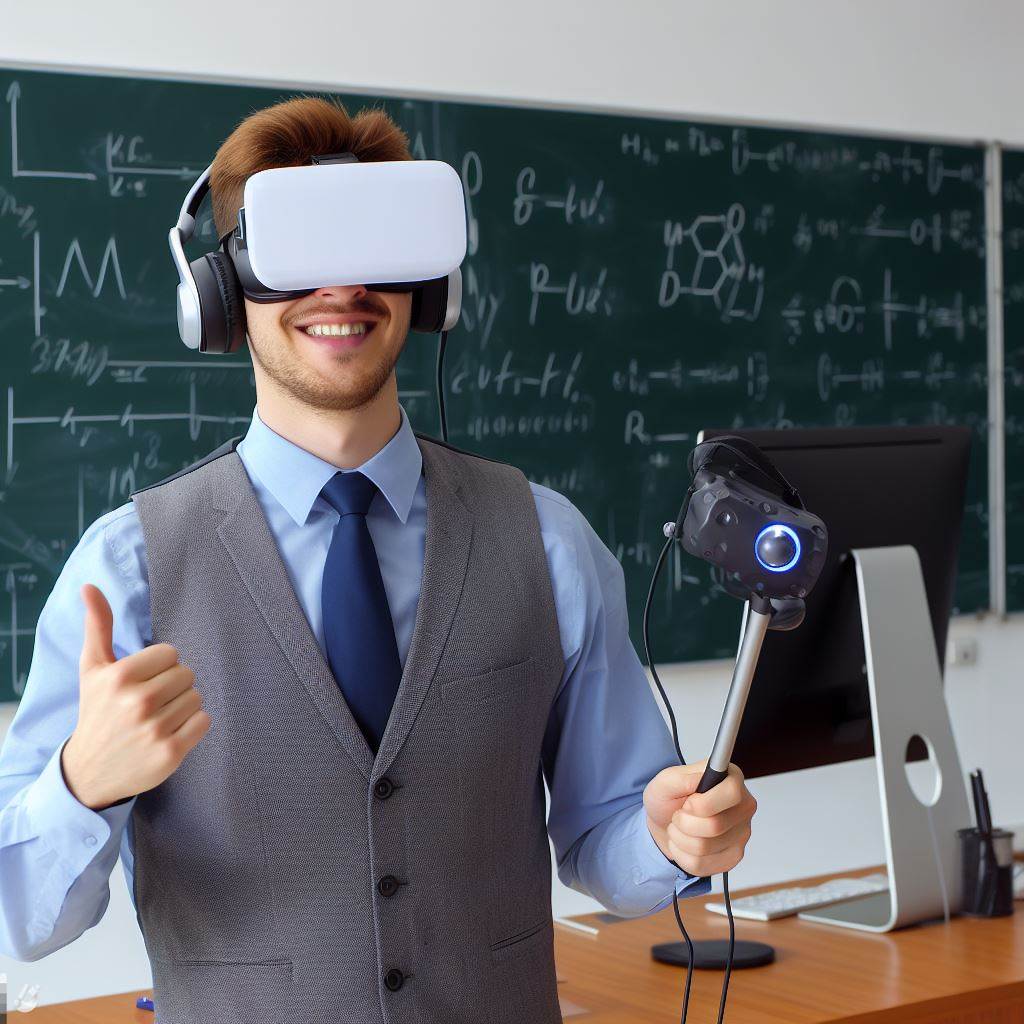Introduction
A. Technology in Teaching in the UK
Embracing technology has become integral for UK lecturers, transforming traditional teaching methods into dynamic, interactive experiences.
B. Importance of Technological Tools for Lecturers
- Enhancing Teaching Methods: Technology offers diverse tools, from interactive presentations to virtual simulations, enriching the teaching repertoire.
- Engaging Students: Utilizing tech tools fosters student engagement, making learning immersive and catering to diverse learning styles.
- Accessibility and Flexibility: Digital resources ensure materials are accessible anytime, fostering a flexible learning environment that aligns with modern lifestyles.
- Real-world Application: Integrating technology provides students with skills applicable in today’s tech-driven workplace, aligning education with industry needs.
- Data-Driven Insights: Lecturers can utilize analytics tools to understand student progress, enabling targeted interventions for better learning outcomes.
In this blog post, we will delve deeper into specific technological tools embraced by UK lecturers, exploring their impact and relevance in the evolving landscape of education.
Online Learning Platforms
Online learning platforms such as Moodle and Blackboard have become invaluable tools for lecturers in UK universities.
A. Organization of Course Materials
Lecturers utilize these platforms to efficiently organize and manage course materials for students.
Files, including lecture notes, readings, and supplementary resources, can be easily uploaded and accessed by students at any time.
This ensures that students have a centralized location to find and review course materials, promoting better understanding and retention of information.
B. Assignment Management
Online learning platforms also enable lecturers to efficiently distribute assignments and collect students’ submissions.
Through these platforms, lecturers can create and upload assignments, set deadlines, and track students’ progress.
Students can submit their assignments electronically, saving time and resources for both students and lecturers.
Furthermore, online platforms offer features that allow lecturers to provide feedback and grades to students, enhancing the learning experience.
C. Enhanced Communication and Collaboration
One of the significant benefits of online learning platforms is the facilitation of communication and collaboration among students and lecturers.
Through discussion boards and forums, students can engage in online discussions, ask questions, and seek clarifications.
This allows for a more interactive learning environment, fostering peer-to-peer learning and knowledge-sharing.
Lecturers can provide guidance, facilitate discussions, and address common misconceptions, promoting a deeper understanding of the course content.
D. Flexibility in Learning
Online learning platforms offer students the flexibility to access course materials at their own convenience, accommodating different learning styles and schedules.
Personalized UK Career Consulting
Receive tailored career guidance designed just for you. Get actionable steps and expert support to boost your career in 1-3 days. Take control of your career now.
Get StartedStudents can review lecture recordings, access course materials, and participate in discussions from anywhere and at any time.
This flexibility is particularly beneficial for students who work part-time jobs, have family responsibilities, or commute long distances.
It ensures that students do not miss out on valuable course content and resources, leading to a more inclusive and accessible learning experience.
Online learning platforms have revolutionized teaching in UK universities, providing lecturers with powerful tools to organize course materials, manage assignments, and foster collaboration.
By offering a centralized location for resources and facilitating communication, these platforms enhance the learning experience and accommodate different learning needs and schedules.
As technology continues to advance, it is crucial for lecturers to embrace online learning platforms to maximize the benefits they offer in today’s digital age.
Read: Career Progression for Lecturers in the UK
Presentation Tools
When it comes to teaching, the use of presentation tools has become increasingly popular among UK lecturers.
These tools, such as PowerPoint and Prezi, offer numerous advantages that enhance the learning experience in the classroom.
A. The Advantages of Using Visual Aids and Multimedia Elements
Visual aids and multimedia elements play a crucial role in engaging students and making the content more interactive.
These tools allow lecturers to present complex information in a simplified and visually appealing way.
One of the main advantages of using visual aids is that they help students understand and retain information better.
Research has shown that the use of visuals in presentations can significantly improve learning outcomes.
Visuals stimulate both the visual and auditory senses, enhancing the overall learning experience.
Your Dream Job Starts with a Perfect CV
Get a tailored CV and cover letter that captures your unique strengths and stands out in your industry. Let us help you make an unforgettable first impression.
Get StartedFurthermore, multimedia elements, such as videos and animations, can bring topics to life.
They can help students visualize abstract concepts, making the content more relatable and understandable.
Lecturers can use videos to demonstrate real-life examples, which can greatly enhance students’ comprehension and knowledge retention.
Moreover, visual aids and multimedia elements make presentations more engaging.
By incorporating images, charts, and graphs, lecturers can effectively capture students’ attention and maintain their interest throughout the session.
This engagement prevents students from becoming passive listeners and encourages active participation.
B. Incorporating Interactive Features
Apart from visual aids, presentation tools also offer interactive features that promote student participation.
Lecturers can incorporate quizzes and polls into their presentations to assess students’ understanding and encourage active learning.
Quizzes can be used to test students’ knowledge before, during, or after a lecture.
They provide immediate feedback, allowing lecturers to identify areas of weakness and reinforce key concepts.
Quizzes also promote healthy competition among students, motivating them to actively engage with the material.
Polls, on the other hand, allow lecturers to gather students’ opinions and preferences.
They can use polls to facilitate discussions and debates, encouraging students to express their viewpoints.
Polls foster a sense of inclusivity and enable lecturers to address different perspectives, leading to a more well-rounded learning experience.
Optimize Your LinkedIn for Success
Boost your LinkedIn profile with a professional bio, keyword-rich headline, and strategic recommendations that attract recruiters. Stand out from the crowd and get noticed.
Optimize NowC. Evaluating the Effectiveness
While presentation tools offer numerous benefits, it is essential to evaluate their effectiveness regularly.
Lecturers should assess whether the visual aids and multimedia elements align with the learning objectives and if they truly enhance students’ understanding.
Additionally, lecturers should consider the accessibility and inclusivity of these tools.
It is crucial to ensure that visually impaired students or students with diverse learning needs can also benefit from the presented content.
Providing alternative formats, such as text versions or audio descriptions, can enhance inclusivity and accommodate different learning styles.
Incorporating presentation tools into teaching practices has revolutionized the learning experience for students in the UK.
Visual aids and multimedia elements enhance engagement, facilitate understanding, and promote active participation.
By incorporating interactive features, lecturers can further enhance student involvement and assess their comprehension.
However, it is vital to regularly evaluate the effectiveness and inclusivity of these tools to ensure an optimal learning experience for all students.
Read: Teaching vs Research: UK Lecturers’ Roles
Virtual Reality (VR) and Augmented Reality (AR)
Virtual reality (VR) and augmented reality (AR) have revolutionized teaching methods in the UK.
The concept of VR involves the use of computer technology to create a simulated environment that users can interact with. AR, on the other hand, overlays digital information onto the real world.
A. The use of VR and AR tools by UK lecturers to create immersive learning experiences
UK lecturers are increasingly utilizing VR and AR tools to create immersive learning experiences for their students.
These technologies offer a unique way to engage learners by providing them with a hands-on approach to complex subjects and practical skills.
One key benefit of VR and AR in teaching is their ability to transport students to virtual worlds that are otherwise inaccessible.
For example, students studying history can visit ancient civilizations and experience historical events firsthand.
This immersive experience enhances their understanding and makes learning more enjoyable.
B. Potential benefits of VR and AR in teaching complex subjects and practical skills, providing students with a hands-on approach
In the field of science, VR and AR allow students to explore complex concepts and conduct virtual experiments.
This not only makes learning more interactive but also helps students visualize abstract ideas, making them easier to comprehend.
Moreover, VR and AR provide a safe environment for students to practice practical skills.
Medical students, for instance, can perform virtual surgeries and train without the risk of harming real patients.
This hands-on training allows them to gain confidence and experience before entering the real world.
VR and AR also cater to different learning styles.
Kinesthetic learners, who benefit from physical activities, can engage with the virtual environment and interact with objects.
Visual and auditory learners, on the other hand, can absorb information through the visual and audio elements incorporated in these technologies.
Additionally, VR and AR tools foster collaboration and teamwork.
Students can work together in a shared virtual space, regardless of their physical locations.
This enables them to engage in group discussions, problem-solving activities, and simulations, enhancing their critical thinking and communication skills.
The potential applications of VR and AR in teaching are vast.
Art students can use VR to create and exhibit their artwork in virtual galleries.
Architecture students can visualize and explore their designs in 3D.
Language learners can practice conversational skills with AI-powered AR chatbots.
C. Challenges with Implementation of VR and AR
However, the implementation of VR and AR in education does come with challenges.
The cost of acquiring these technologies, training lecturers, and maintaining the equipment can be a barrier.
Additionally, not all students may have access to the required hardware, limiting inclusivity.
Essentially, VR and AR have become powerful tools in the arsenal of UK lecturers.
These technologies provide immersive learning experiences that enhance understanding, cater to diverse learning styles, and foster collaboration.
While challenges exist, the potential benefits of integrating VR and AR into teaching are tremendous, paving the way for a more engaging and effective educational landscape.
Read: Qualifications Needed for UK Lecturers

Explore Further: Remote Training Strategies in UK
Collaborative Tools
Collaboration is an essential aspect of education, promoting teamwork and effective communication among students.
With the advancement of technology, lecturers in the UK have embraced various collaborative tools to facilitate these interactions.
A. Importance of collaborative tools in fostering teamwork and communication among students
Collaborative tools play a crucial role in enhancing teamwork and communication among students.
By actively engaging in group activities, students learn to work together, share ideas, and solve problems collectively.
Moreover, these tools provide an inclusive environment where every student can contribute and participate, promoting a sense of belonging and encouraging active learning.
B. Popular collaborative tools used by UK lecturers
In the UK, lecturers have recognized the significance of collaborative tools and have integrated them into their teaching practices.
One popular collaborative tool used by UK lecturers is Google Docs.
This web-based application allows students to create and edit documents simultaneously, fostering real-time collaboration.
Students can comment, suggest edits, and provide feedback on each other’s work, driving peer learning and improvement.
Similarly, Microsoft Teams has gained popularity among UK lecturers as it enables seamless collaboration within the classroom.
Lecturers can create teams or groups, allowing students to work together on projects, share resources, and communicate effectively.
The integrated chat feature facilitates instant messaging, promoting quick discussions and problem-solving.
Moreover, lecturers can easily monitor individual contributions and provide timely feedback to ensure equal participation and encourage growth.
C. How lecturers can use these tools to facilitate group projects, peer feedback, and real-time collaboration
Lecturers can harness these collaborative tools to facilitate group projects, peer feedback, and real-time collaboration effectively.
When working on group projects, students can create shared documents using tools like Google Docs or Microsoft Teams.
This ensures that every member has access to the project and can contribute to its development.
Furthermore, students can collaborate in real-time, editing the document simultaneously and discussing ideas through the integrated chat or commenting features.
1. Peer feedback
Peer feedback is an invaluable skill that can be fostered through collaborative tools.
Lecturers can assign students to review and provide feedback on their peers’ work, using tools like Google Docs.
By granting commenting permissions, students can share constructive feedback, suggest improvements, and help each other grow academically.
This promotes a culture of continuous learning and encourages students to engage critically with their own and their peers’ work.
2. Real-time collaboration
Real-time collaboration is another significant benefit offered by collaborative tools.
Students can work on projects together, regardless of their physical presence.
This fosters inclusivity, allowing students to collaborate remotely and eliminating geographical barriers.
Lecturers can observe the progress, offer guidance in real-time, and provide immediate feedback.
This enhances the overall learning experience and encourages students to take ownership of their education.
In general, collaborative tools have become indispensable in education, particularly in the UK, as they foster teamwork and communication among students.
By utilizing tools like Google Docs and Microsoft Teams, lecturers can facilitate group projects, peer feedback, and real-time collaboration effectively.
These tools not only enhance the learning experience but also equip students with essential skills required in the professional world.
As technology continues to evolve, it is imperative for lecturers to embrace these tools to empower students and promote collaborative learning environments.
Read: Lecturers’ Salaries in the UK: An Overview
Assessment and Feedback Tools
A. The use of technology in assessment and feedback processes in UK universities
In the world of education, technology has revolutionized the way assessments and feedback are conducted in UK universities.
Lecturers have embraced various tools, such as online quizzes, automated grading systems, and feedback platforms, to enhance the assessment process and provide valuable feedback to students.
B. How lecturers utilize tools like online quizzes, automated grading systems, and feedback platforms
Online quizzes have become a popular means of assessment in UK universities.
These quizzes can be easily created and administered through online platforms, allowing lecturers to assess students’ knowledge and understanding of the course material.
These quizzes can be customized to include various question formats, such as multiple choice, true/false, or short answer questions.
Automated grading systems have also been widely adopted by lecturers in UK universities.
These systems use algorithms to automatically grade student responses, eliminating the need for manual grading.
This not only saves time for lecturers but also provides students with immediate feedback on their performance.
Feedback platforms have emerged as a crucial tool for lecturers to provide timely and constructive feedback to students.
These platforms allow lecturers to leave comments, suggestions, and corrections on students’ assignments or exams.
Students can then access their feedback electronically, enabling them to review and learn from their mistakes.
C. Advantages of using technology in assessments
The advantages of using technology in assessments are numerous.
Firstly, technology enables faster grading, as automated systems can quickly process and evaluate large volumes of student work.
This saves lecturers significant time and allows them to provide feedback promptly, benefiting students’ learning process.
Furthermore, technology in assessments facilitates immediate feedback. Instead of waiting for weeks to receive feedback on an assignment or exam, students can access their results and feedback online within a matter of days or even hours.
This allows them to reflect on their performance, identify areas for improvement, and take corrective measures.
Another advantage of utilizing technology in assessments is the generation of performance analytics.
With the help of automated systems, lecturers can collect valuable data on student performance, such as average scores, common mistakes, and areas of difficulty.
This data can inform lecturers’ instructional practices, helping them identify teaching gaps and adapt their teaching strategies to better support student learning.
In essence, the use of technology in assessment and feedback processes has transformed the landscape of teaching in UK universities.
Online quizzes, automated grading systems, and feedback platforms have revolutionized the way lecturers assess students and provide feedback.
The advantages of using technology in assessments, such as faster grading, immediate feedback, and performance analytics, have greatly enhanced the learning experience for both lecturers and students.
Conclusion
A. Summarizing Main Points
We explored powerful tools UK lecturers employ for effective teaching: interactive presentations, learning management systems, and collaborative platforms.
B. Crucial Role of Technology
Technology is more than a tool; it’s a catalyst for engaging lectures, efficient assessments, and fostering student collaboration.
C. Future Transformations
As we conclude, recognize the ongoing technological strides. Virtual reality, AI, and adaptive learning are on the horizon, promising even more transformative teaching experiences.
In the end, UK lecturers are leveraging technology to revolutionize education, ensuring a dynamic and enriching learning environment for students.
The journey doesn’t stop here; it evolves with technology’s ever-advancing landscape, ensuring education continually adapts and improves.
The future holds exciting possibilities for both educators and learners alike, as technology becomes an increasingly integral part of the educational journey.
[E-Book for Sale]
500 Cutting-Edge Tech Startup Ideas for 2024 & 2025: Innovate, Create, Dominate
$19.99 • 500 Tech Startup Ideas • 62 pages
You will get inspired with 500 innovative tech startup ideas for 2024 and 2025, complete with concise descriptions to help you kickstart your entrepreneurial journey in AI, Blockchain, IoT, Fintech, and AR/VR.




